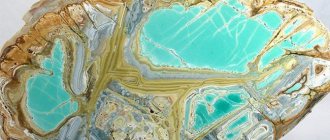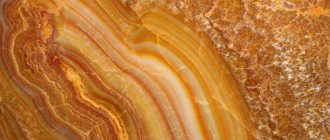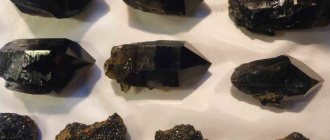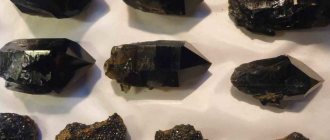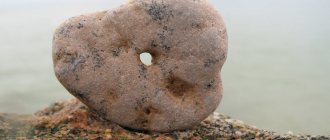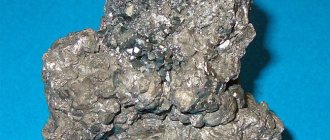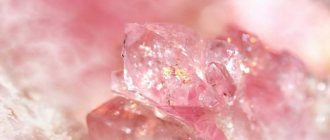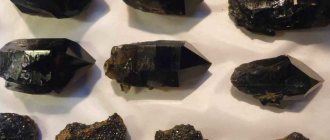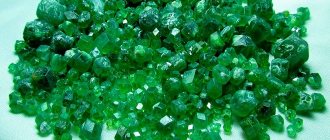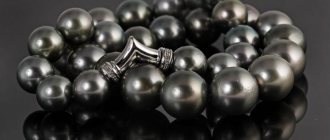Historical reference
Once upon a time in the East, where Afghanistan borders on Tajikistan, ancient people mined marble, which was the main material for the construction of ancient temples and palaces. It was there, in an area called Badakhshan, that workers discovered bright blue inclusions of lapis lazuli in marble blocks.
The emirs of that area declared the nugget to be of rare value. The slaves who mined the stone were chained to the walls of the mines in order to prevent the possibility of theft of lapis lazuli. Since that time, the peoples of the eastern steppes and mountains have revered the mineral as a symbol of the supreme deity Tengri-Sky.
The discoverers of stone used it for cladding palaces and temples. Later, from Afghanistan, the heavenly mineral gradually fell into the hands of the Persians, and then to the Egyptians. Crossing ancient Greece and Rome, lapis lazuli gradually found its way into the hands of Europeans.
- The ancient Egyptians associated lapis lazuli with the main god Amon-Ra, considering the stone a symbol of the highest heavenly justice. Therefore, the judge of ancient Egypt wore a breastplate made of stone with the hieroglyph “truth” carved on it. Products made from lapis lazuli were placed in the tombs of Egyptian pharaohs. One of the ancient rulers in whose burial chamber lapis lazuli jewelry was found was Tutankhamun.
- The Chinese and residents of other Central Asian states symbolized the blue nugget with the power of monarchs and Heaven, which stretched over every person, regardless of who he was - a mandarin, emir, peasant or warrior. There is a belief that it was from Badakhshan lapis lazuli that the boards of Moses were made, on which the prophet inscribed the commandments sent down by heaven.
In addition to its use in construction and symbolism, lapis lazuli has long been used by artists of the East and West as a colorful material. Ultramarine, a bright blue paint based on resin, water or tempera, was made from the mineral crushed into powder.
The name of the nugget has also come a long way. The Persians called the mineral “heavenly stone” or “lazhvard”. And in Europe, as in Russia, until the 18th century the mineral was called by the Latin name “lapis lazuli.” The fame of the nugget in Rus' began during the reign of Ivan the Terrible. The Russian-language names for the stone of that era were “lazurik” and “lazorevik”.
Physical and chemical properties
Lapis lazuli stone
Characteristics: lapis lazuli is a complex compound of aluminum, sodium, silicon, sulfur and oxygen. The composition may contain calcium, individual inclusions of feldspars and pyrite. Belongs to the subclass of frame aluminosilicates. A rock-forming igneous material released from magma very low in silica.
Hardness 5.5. Can be scratched with a knife made of alloy or carbon steel. Doesn't scratch glass.
The rich blue color of lapis lazuli is due to the presence of sulfur in its composition, which partially replaces silicon. Sulfur content - up to 0.7%. The higher it is, the thicker and brighter the color.
Lapis lazuli crystal is a rare occurrence. The usual form of its occurrence in nature is veins in marble or massive blocks. In turn, lapis lazuli can have golden veins, which in ancient times were considered true gold. But this is pyrite, also known as sulfur pyrite, iron disulfide. The blue tit is not a gemstone.
The properties of lapis lazuli make it easy to process, but also easy to damage.
| Formula | Na[(AlSiO4)SO4] |
| Color | Shades of blue |
| Shine | Glass |
| Transparency | Translucent |
| Hardness | 5,5 |
| Cleavage | Implicit |
| Kink | Conchoidal, granular |
| Density | 2.38 - 2.42 g/cm³ |
Physical properties
Lapis lazuli is a complex combination of several elements - sodium, sulfur, aluminum and oxygen. In addition, the mineral may contain calcium, inclusions of pyrite or feldspars. The nature of origin is magmatic.
| Property | Description |
| Formula | Na[(AlSiO4)SO4] |
| Impurities | Spars and pyrite. |
| Hardness | 5,5 |
| Density | 2.38 - 2.42 g/cm³ |
| Refractive index | 1,5 |
| singonia | Cubic. |
| Kink | Conchoidal and granular. |
| Cleavage | Implicit. |
| Shine | Glass. |
| Transparency | Translucent. |
| Color | From dark blue to light blue. |
Sulfur gives the stone its characteristic blue color. The more of this element is contained in the composition, the richer the shade. And ancient people mistook pyrite veins for gold.
This mineral is not a gem. Lapis lazuli is typically found as lumps or veins in marble. The discovery of a lapis lazuli crystal is very rare.
Place of Birth
Lapis lazuli stone from Afghanistan interspersed with pyrite and calcite.
The oldest place is the border of the northern part of Afghanistan and Tajikistan: Badakhshan province. Work is still underway there, and the profit is provided by the Taliban movement and political figures.
Since lapis lazuli is of volcanic origin, it is mined in places where there were previously volcanoes:
- In Russia, the Baikal region (southern part) is considered the place for blue tit production; a lot of it was found along the banks of the Slyudyanka River. The appearance of the crystals is very similar to those from Badakhshan, but the pattern is a little blurry.
- There is another Afghan deposit, near the Pamir Mountains, but the minerals there are not of the same high quality as those from Badakhshan.
- Lapis lazuli is also mined in other countries of the world: Africa, Chile, Namibia, India, China, but the quality there is also not very high and the value is less.
Where is lapis lazuli stone mined today?
Many people know what lapis lazuli looks like, but not everyone knows in which countries it is mined. One of the oldest places where stone is mined is the Badakhshan deposit, located in Afghanistan. It is the lapis lazuli, which is mined on Afghan lands that were previously considered the possessions of the Great Emir, that is considered one of the most beautiful in the world. The thing is that this mineral often contains inclusions of golden-colored pyrite, which makes the stone look like a firmament strewn with stars.
The gem is also mined today in the USA (California), in the south of Transbaikalia in Russia. In the Pamir Mountains, lapis lazuli has been mined for seven thousand years. You can draw a conclusion about this by seeing photos of decorations and rich palaces decorated with them, belonging to ancient eastern rulers.
The properties of Afghan lapis lazuli cannot be compared with others because of its perfection and unprecedented beauty, which can explain the high price of products with it.
Colors and varieties
The mined mineral is not always of a heavenly hue. There are stones of blue and deep blue color. There are minerals with a greenish tint, as well as violet-lilac specimens. The color of the stone can be either uniform or complemented by blots, “eyes” or sheets of various inclusions - pyrite, gray or white spar. Lapis lazuli with veins of feldspars is considered a low-grade material.
The most valuable material is considered to be Badakhshan lapis lazuli. The national stone of Afghanistan is divided into three varieties:
- Niili. The stone is a deep blue color. It can be plain or with pyrite veins.
Lapis Lazuli Niili
- Asmani. Sky blue mineral. It also comes in light blue.
Lapis Lazuli Asmani
- Sufsi. A nugget with a greenish tint and various inclusions.
Lapis lazuli Sufsi
Niili is considered the most expensive variety of Afghan lapis lazuli. The price of such a processed stone inserted into a product reaches 10 US dollars per gram. Sufsi is the cheapest subspecies.
Lapis lazuli from the Russian Baikal region is close in color palette to the Badakhshan mineral. The blue tit from the Pamirs and Chile is paler.
Meaning and description of the stone
Lapis lazuli is an ornamental semi-precious stone of the first order. It has a relatively low cost and is mined in large quantities in different countries around the world.
The mineral is not a gemstone. In most cases, it is found as large inclusions and veins in other rocks (usually granite). Occasionally, nuggets in the form of crystals are found.
Another name is lapis lazuli. Under it, the mineral was known in Europe and Russia until the 18th century. It has a blue or light blue tint and is completely opaque. Usually the stones have blue veins and inclusions due to the pyrite content.
In addition to golden sparkles of pyrite, which give the stone a glow, there are often spots of feldspars on its surface. Rarer specimens have a greenish and lilac tint.
The mineral is a complex compound of sulfur, silicon, sodium, aluminum and oxygen. It is sulfur that gives it a blue tint, and the color saturation depends on its amount. The amount of sulfur in lapis lazuli reaches 0.7%. It partially replaces silicon in crystals.
The natural stone lapis lazuli both in appearance and name resembles azurite. Minerals have different formulas. The latter has a lower density, more obvious color transitions, but there are no golden inclusions of pyrite.
Additionally, watch the video review:
Varieties and colors
One of the oldest deposits is located in Afghanistan. The brightest and most expensive stones are mined there. It was the Afghans who came up with a classification of stones depending on their appearance and the number of different inclusions:
- Niili. Bright blue homogeneous lapis lazuli with gold veins. It is considered the most valuable variety.
- Asmani. Blue mineral. It contains noticeable golden sparkles of pyrite.
- Sufsi. Stones with a green tint. They have inclusions of base stones (usually feldspar). They have the lowest cost.
The color range of the mineral is quite wide. There are blue and blue stones, turquoise and even purple.
The mineral is also divided into varieties depending on the pattern and structure:
- Homogeneous. It has a uniform shade, without any impurities. Most valued in the jewelry industry.
- Spotted. Decorated with small spots of foreign impurities. The structure is heterogeneous. It is actively used in the manufacture of amulets and decorative items.
- Veined-spotted. It is unevenly colored, has large veins and inclusions of foreign impurities. Used for interior decoration and the manufacture of decorative items.
Azurmalachite is often confused with lapis lazuli. In fact, this crystal is a compound of azurite and malachite. It has a blue-green tint.
Healing properties
A vase made of lapis lazuli at the Kremlin exhibition in 2011.
In the Middle Ages, crushed lapis lazuli was often used as an antiemetic for poisoning. This powder really has healing properties that are similar to the mechanism of action of activated carbon. However, today no one uses the gem like that. This is due to the high cost of such treatment.
However, modern lithotherapists often use lapis lazuli. Today its ability to restore visual functions is known. To do this, it is recommended to systematically peer into the crystal. It is recommended to do this at least twice a day for 10-15 minutes. In addition, the mineral has other valuable characteristics:
- Pendants and necklaces with lapis lazuli help normalize emotional background. They are great at managing the physical symptoms of stress. These include tachycardia, rapid breathing, and a feeling of a lump in the chest.
- Earrings or a pendant with a mineral help strengthen hair. These decorations help make them thicker, shinier and stronger.
- The mineral copes well with disruptions in the functioning of endocrine organs. Lapis lazuli helps improve a person's condition with diabetes or thyroid pathologies. At the same time, it is strictly forbidden to refuse the help of official medicine, since there is a risk of a significant deterioration in health.
- Lapis lazuli also copes with pathologies of the respiratory system. It is useful to wear a pendant or necklace during periods of relapse of bronchial asthma, pneumonia or bronchitis.
- A bracelet with a gem helps normalize cardiac functions. In this case, the jewelry should be worn on the left hand - in the place where the pulse is felt. An energy meridian is directed from this point to the heart, the functions of which are activated due to the healing characteristics of lapis lazuli.
To fully demonstrate the healing properties of the mineral, it is recommended to wear it daily for at least 2 hours. This should be done for 10-15 days. At the same time, it is impossible to refuse official methods of treatment. Any disease is a complex phenomenon. Therefore, it needs to be treated on a physical and energetic level.
Medicinal properties
The healing properties of lapis lazuli have been known since ancient times. Powdered heavenly stone saved from poisoning and got rid of parasites. Now hardly anyone uses it for this purpose, because there are modern, less expensive means.
Lithotherapists use lapis lazuli balls for massage for blood diseases and high blood pressure.
Contemplation of lapis lazuli restores visual acuity and perfectly calms the nervous system, improves sleep, and wearing beads helps to cope with lung diseases.
Magical properties of lapis lazuli
Lapis lazuli has long been considered a symbol of friendliness, sincerity, purity of thoughts, serving as an instrument of white magic. The magical power of the nugget acts both on the consciousness of its owner and on the thoughts of the people around him. The mineral helps the owner make the right decisions and live according to the will of his conscience. The stone involuntarily diverts people who want to harm the owner of the gem from a bad idea. The mineral protects a person from envy, intrigue, damage and other negativity.
This is interesting!
The magical properties of lapis lazuli depend on the setting of the stone. The mineral in gold will enhance intuition and attract the attention of others, in particular, people of the opposite sex. Silver helps lapis lazuli protect a person from dark magic.
Lapis lazuli is endowed with an unusual ability - to change the world around us, the destinies of people. Anyone who wants life changes should acquire lapis lazuli jewelry - a bracelet or beads.
Such a talisman will help a person turn the thread of fate, for example, break off a painful relationship, move to another city or country, find a new job and make the necessary contacts. The mineral imparts wisdom, helps to make only the right decisions, which a person will not regret later. The power of the stone will help you forget past grievances and let go of the past.
Among the main magical capabilities of the heavenly stone is the cleansing of thinking from unnecessary “garbage”. Lapis lazuli makes a person calmer, cooler, promotes thinking, but at the same time slows down the reaction.
This contributes to the ideal compatibility of the mineral with people of such professions as priests, scientists or lawyers, that is, all those who need sober and unhurried thinking. Accordingly, such an influence makes lapis lazuli incompatible with people in business that require quick reactions - military personnel, rescuers, drivers, production workers, and so on.
A little magic
Lapis lazuli is a stone that gives the owner happiness. He does not need to talk about his dreams, to “guide” his work. According to experts, he is able to bring both luck and love, prosperity and success into life. The stone simply responds to the internal needs of its owner at a given moment in time. It is believed that it helps to attract everything new into life: from people to ideas. In this case, every chance turns out to be a winning one.
You just need to use the gifts that lapis lazuli gives. Its magical properties do not end there. If you admire it daily, your vision will be restored. Those who wear rings with lapis lazuli experience normalization of the circulatory system (if there were any disruptions). Buckles with this mineral are especially recommended for pregnant women. Being near the fetus, it helps its normal development, protects the baby and mother from negative energy-informational influences.
Talismans, amulets, amulets
The stone can be worn under clothing or as jewelry. He is capable of collecting all the negativity directed by envious people or simply unkind people. When working in a team, it is better to have silver jewelry.
If the mineral is in gold, it will attract love and good luck to the owner. Beads, bracelets and pendants help to radically change your destiny.
If it is frameless, it can alternatively be carried in a handbag or in an inside clothing pocket.
If there are several stones in a product, then their cleansing power is enhanced.
Areas of application
Lapis lazuli is the most famous blue mineral, which in its best examples has valuable decorative qualities. According to the classification of A. Fersman and M. Bauer, this mineral is classified as semi-precious ornamental stones of the first order. For comparison, it can be noted that the same (first) order of ornamental stones includes such materials as: jade, vesuvian, glauconite, sodalite, amazonite, labradorite, orlets, malachite, aventurine, quartzite, smoky quartz, rock crystal, agate (with its varieties), jasper, Hebrew stone and rose quartz.
Lapis lazuli eyebrows on the mask of Tutankhamun (1341-1323 BC), Cairo Museum
Of all the blue opaque stones known in ancient times, lapis lazuli was one of the most highly valued. This ornamental mineral was used to make amulets, vases, boxes and other expensive household items, as well as as a material for making expensive mosaics and inlays.
The modern name appeared only in the Middle Ages; in Pliny's time this stone was called sapphire.
Pliny gives this description of it:
“For sapphire also sparkles with specks like gold. It is also azure in color, although it is sometimes, but rarely, purple.”
In these words he describes in detail lapis lazuli, which has a blue color, sometimes modulating to purple, and very often contains scattered inclusions of pyrite, which in luster and color resembles gold.
In the Middle Ages, lapis lazuli was used in medicine and technology. In ancient medical manuals, recipes are constantly found according to which the so-called “Confectio Alkermes” were prepared from the grated substance, which, when taken orally in an amount of 20 or 25 grains, caused vomiting. Icon painters, as well as artists in later times, prepared (rubbed) expensive bright blue ultramarine paint from azure stone.
History and origin of the name
In ancient times, Afghanistan was part of the Persian Empire, so the modern name of lapis lazuli comes from the Persian word “lahvard”, which meant this stone. Then the word passed into European languages in the form of “lapis lazuli”, and in the 18th century it received the modern sound “lapis lazuli”. In Rus' he came under Ivan the Terrible, here he was called “blue-blue” or “lazurik”.
In ancient times, marble was mined in Badakhshan, from which the rulers of eastern countries built palaces. But sometimes it contained inclusions of a sky-blue stone, which began to be revered as a symbol of the supreme deity Tengri.
Legends say that the slaves who mined this beautiful gem, which immediately became a great gem, were chained to a rock so that not a single pebble would be stolen. They also say that slaves who could no longer work for health reasons were even killed so that they would not tell anyone about the place where the precious mineral was mined.
From Afghanistan, lapis lazuli spread throughout the world. Inserts from it decorate the funeral mask of the Egyptian pharaoh Tutankhamun; it was also found during excavations in Troy.
The ancient Chinese considered lapis lazuli to be a symbol of Heaven, which watches over people and played a central role in the philosophy of Taoism. This stone was given the highest dignity and was considered the main thing among stones, just as the emperor was the main thing among people.
The Greeks often confused it with sapphire, even Pliny the Elder described it as sapphire, shimmering with gold, and sometimes having a purple hue, which was very highly valued in ancient times. Pyrite inclusions, often present in lapis lazuli, were mistaken for gold.
A new surge in the popularity of the stone was associated with icon painting. At a time when the main colors were made on the basis of tempera, only this stone could convey the azure of the sky. No wonder its color is called azure.
The process of obtaining a paint called “ultramarine” was very complicated. First it had to be separated from the white veins, which required a lot of patience. This was achieved using wax and repeated shaking with water. The price of such paint was more than that of gold.
With the advent of oil paints, the value of lapis lazuli fell, since diluted lapis lazuli became translucent and was only suitable as a glaze paint. But if the artist was wealthy or the customer could afford this expensive paint, then in order to “gain weight,” ultramarine was diluted in resin.
With the advent of artificial ultramarine in the 20s of the twentieth century, lapis lazuli is rarely used as a paint, but it is still valued among icon painters who prefer natural pigments.
Columns decorated with Afghan lapis lazuli decorate the entrance to the altar in St. Isaac's Cathedral and the doors of the Cathedral in Kronstadt. Nowadays they make jewelry, figurines and other crafts from it.
Lapis lazuli in jewelry
Tsarevich (Faberge egg) 1912.
Virginia Museum of Fine Arts, USA Jewelry lapis lazuli is a dark blue polymineral aggregate without visible light inclusions. Jewelry varieties include dense lapis lazuli in dark blue, cornflower blue and violet colors. Processed with cabochon or plates. In lower grades, spots of white, blue and gray are allowed, occupying, respectively, no more than 15% of the total surface area of the stone. In the most expensive lapis lazuli from Badakhshan (Afghanistan), golden sparkles of pyrite inclusions are common.
Lapis lazuli is used in jewelry as an inexpensive but beautiful ornamental stone. Lapis lazuli is a rather soft and brittle mineral, easy to process and polish.
Lapis lazuli can be additionally painted blue or imitated (fake) by painting white stones blue.
Decorative vases, boxes, and figurines are made from lapis lazuli. In the form of thin plates, they are used for inlay in artistic mosaic works, as well as for cladding columns, fireplaces, etc. One of the most valuable and most ancient mineral pigments.
Official seal of the President of Ukraine
The most expensive samples of high-quality lapis lazuli have long been considered the royal (imperial) stone and were used to make state regalia, royal household items and the highest gifts.
In particular, Mikhail Pylyaev writes that in 1873, during the stay of the German Emperor Wilhelm I in St. Petersburg, Alexander II made his august guest many rich gifts, including several vases and other decorations for the desk made from “lazure.” stone." Among these gifts, a miniature model of the monument to Peter I stood out with particularly fine workmanship, in which the rock was made of excellent lapis lazuli, and the statue itself was made of matte silver.
The handle of the official seal of the President of Ukraine is decorated with a lapis lazuli ball, resembling a photograph of the Earth from space (the texture of the stone gives this effect).
Modern mining and counterfeits of lapis lazuli
Until the beginning of the 19th century, the stone was mined in only one place. The Badakhshan deposit is the oldest, but mining continues here today. This is where the highest quality, purest and most expensive minerals in the whole world are found. The value of this stone is increased by golden inclusions of pyrite, due to which the surface of the mineral resembles a starry sky.
At the moment, there are many deposits of stone scattered around the planet, however, such high quality is not found anywhere else. The Pamir lapis lazuli (Tajikistan) is closest in its properties, however, it contains impurities of diopside and dolomite, which significantly reduce its cost. As for other deposits, the quality there is even worse, which is why the price of lapis lazuli is low.
For the first time, lapis lazuli began to be counterfeited not in Thailand or China, but in Ancient Egypt. It was here that glaze and glass began to be used, replacing heavenly stone. Nowadays, fakes can be found even in expensive jewelry stores, so you need to make sure the stone is authentic. The most similar mineral is sodalite; they are also now producing synthetic stone, which is grown artificially. Low quality gold is used as pyrite inclusions.
Another type of counterfeit is lapis lazuli. In fact, this rock contains lapis lazuli, but the amount of impurities here is simply off scale. Lapis lazuli contains mica, but dyes hide the imperfections of the stone. Swiss lapis is jasper or chalcedony impregnated with blue paint. To determine the authenticity of a stone, a laboratory spectral analysis must be performed. It is worth noting that only natural lapis lazuli has healing and magical properties.
How to recognize a fake
Mechanical chronometer "Tuareg".
The clothes and headband are made of Afghan and Pamir lapis lazuli. The price of lapis lazuli is not too high; they are mostly counterfeited niili, which are quite expensive. On the other hand, the mineral itself is often passed off as more expensive stones - sapphire, sodalite.
How to distinguish a fake? Most often, lapis lazuli is imitated using painted glass or plastic. A more complex “art” is the refinement in laboratory conditions of a low-grade sufsi gem or azurite, similar to the heavenly stone.
If a scammer is going to pass off a mineral as a sapphire, then he will most likely simply rely on your ignorance of what lapis lazuli stone looks like and how it differs from more expensive rocks.
The most reliable way is to show the gem to a jeweler or geologist. But not everyone has this opportunity, so you will have to expose the scammers yourself.
- Natural minerals are rarely perfect. Under a magnifying glass, even on the most ideal crystal you can see scratches, cracks, and small inclusions.
- Immerse the jewelry in water. It will form drops on the plastic, and the natural stone will be evenly moist.
- The stone sparkles brightly in the sun's rays, but not in artificial light. A fake will always shine.
- If you squeeze the mineral in your fist, it will remain cold, but the glass or plastic will heat up from the warmth of your hands.
You need to check the authenticity of your jewelry not only to be sure that you did not buy a piece of plastic for the price of a stone. Only natural lapis lazuli has magical and healing properties. Never fake. If you bought a precious mineral and were given lapis lazuli, then, of course, you can use it as a talisman. But sapphire or sodalite have completely different energy and other magical features.
About jewelry
Rings with this mineral, necklaces and beads made from it are undoubtedly beautiful. You just need to take into account that the stone “loves” the sun’s rays. He imbues himself with them, playing in the eyes of the audience. But artificial lighting “does not like” lapis lazuli; it fades and becomes dull. This mineral goes well with silver. We can say that they have related functions. They protect against the evil eye, damage, and so on.
For women with voluminous hair, such a hairpin or hoop will not be out of place. It's a great help for energy. It seems like a simple decoration, but it will cleanse blood and thoughts at the same time. You can also make a necklace with lapis lazuli: insert stones into a silver chain in a strict or random order. And if there is only one lapis lazuli, then it will make a pendant, the constant wearing of which will contribute to the emergence of cordiality and openness towards the world.
Stone compatibility
Lapis lazuli is one of the classic stones of the Earth. Other earthly rocks are jasper, jade, agates and chalcedony of all types and varieties, crocodile, malachite, turquoise, labradorite and morion. All these are opaque stones. Lapis lazuli is compatible with any of them.
A good combination is a company with Water gems:
- emerald;
- precious opal (except black);
- aquamarine;
- topaz;
- pearls;
- goshenite;
- peridot;
- euclase.
It is strictly unacceptable to combine with Fire - almandine, pyrope, grossular, all types of garnet, except demantoid and uvarovite. Particular attention should be paid to ensure that lapis lazuli does not get into the company of a diamond or ruby - they will “destroy” it.
The combination with Air - the mentioned demantoid and uvarovite, rock crystal and other clear quartz, rauchtopaz, golden beryl, amazonite, amethyst and chrysoprase - is neutral.
Who is lapis lazuli suitable for according to their zodiac sign?
Beads natural stone Lapis lazuli
Lapis lazuli and zodiac signs are not always compatible. This is an ideal talisman for people born on September 13th. The stone brings maximum benefit to Taurus, Sagittarius, Libra and Leo according to the horoscope.
Moreover, the more specific properties of the stone differ depending on the zodiac sign:
- Aries - for representatives of this sign, the stone is considered the real embodiment of love and family well-being. It helps to achieve tenderness and create a cozy atmosphere in the house. Lapis lazuli is especially suitable for Aries who are involved in charity work.
- Taurus - lapis lazuli is considered the real embodiment of success and helps to achieve your goals. The stone can be used as an amulet for Taurus women. It helps you achieve success in love and career. The heavenly stone provides special support to people who live according to the laws of justice. It can be used to improve financial well-being.
- Gemini - receive support from the crystal in all endeavors. A talisman that has a natural stone becomes a real embodiment of good luck and financial stability. It helps Gemini achieve success in their professional activities.
- Cancer - for them lapis lazuli becomes a real anchor on the path of life. Thanks to this mineral, it will be possible to avoid falling into a dangerous and risky path. In addition, natural stone has a beneficial effect on the emotional state of Cancers, provides protection against depression and aggression, and helps avoid self-absorption. With the help of this mineral it is possible to normalize mental balance and shift the emotional background in a positive direction. Pregnant women and people who are prone to depression have a special need for lapis lazuli.
- Leo is a stone that helps representatives of this sign normalize their emotional state. For them, the mineral becomes a real mentor. With its help, you can make informed and thoughtful decisions, as well as resist stress. It is permissible to carry the mineral with you as a personal talisman. Thanks to this, you can change your destiny for the better. Lapis lazuli also promotes the development of certain character traits - honesty, wisdom, nobility. This is a wonderful stone for travel.
- Virgo - this stone is required for those who are forced to constantly contact people. With its help, it is possible to reduce anxiety and cope with self-doubt. Lapis lazuli helps to facilitate communication with others and improve relationships with them. In addition, the stone helps to attract good luck to Virgos.
- Libra - lapis lazuli can be used as a talisman that helps protect physical and psychological health. The talisman also helps you achieve your goals and find your place in life.
- Scorpio is a mineral that improves the situation in the professional sphere and helps attract the right people into your life. With the help of the mineral it is possible to improve the character of representatives of this difficult sign.
- Sagittarius – representatives of this sign are recommended to wear lapis lazuli from time to time. It is best to wear jewelry with this stone when making vital decisions. The mineral helps to find new ideas. It can also help improve your health. The stone reflects favorably on people who are engaged in the creative field or help others.
- Capricorn - for people who belong to this zodiac constellation, lapis lazuli helps them find a kind of balance between eccentricity and seriousness. It helps direct the flow of energy to develop internal potential, helps strengthen willpower and increases self-confidence. The stone helps to seek life goals and achieve them.
- Aquarius - representatives of this sign can also use lapis lazuli as a talisman. With its help, it is possible to achieve harmony in the inner world, cope with fears and self-doubt. Lapis lazuli also helps overcome depression and despondency. If you use the mineral as a personal amulet, Aquarians will be able to improve their health and recharge themselves in a great mood.
- Pisces - the stone helps representatives of this sign maintain health. Real lapis lazuli helps Pisces cope with headaches and skin diseases. The mineral also improves mental state.
In general, lapis lazuli is considered a very positive stone that helps improve the lives of representatives of all zodiac signs. At the same time, he does not tolerate deception and resourcefulness well. You should not expect help for aggressive and unbalanced people. This talisman is suitable only for creative and noble individuals.
Properties and uses of lapis lazuli
Lapis lazuli is mined on an industrial scale. Most of the nuggets are used to make jewelry and beads for crafts.
You can also find jewelry with stones in jewelry stores. These are usually limited edition designer collections. Lapis lazuli is used to make decorative items. Figurines, boxes, etc. are made from it.
Stone is also used for finishing work. They are used to decorate room walls, kitchen units and furniture fittings. Natural paint is made from lapis lazuli. It is used for painting icons.
Physicochemical characteristics
Lapis lazuli is an aluminum silicate. It has the following chemical formula: Na[(AlSiO4)SO4]. The nugget contains aluminum, sodium, sulfur, silicon and oxygen. Specimens with shiny inclusions of pyrite are often found. There are stones that have other rocks in their structure, such as feldspar.
There are stones of various shades of blue, even lilac.
The intensity of the color is determined by the sulfur contained in the composition. Untreated minerals have no shine. After grinding and polishing they acquire a glassy shine.
Lapis lazuli is not a very hard stone. It does not leave scratches on the glass. On the mineralogical scale it is rated 5.5. Cleavage is not expressed. The fracture is granular or conchoidal. Density is low. There are opaque and translucent specimens.
View this post on Instagram
Publication from STONES? rosary? BRACELETS (@minerals_love_) Jun 21, 2019 at 1:39 PDT
Medicinal properties
Since ancient times, lapis lazuli has been attributed medicinal properties. It was believed that this stone had the ability to heal wounds, stop bleeding and cleanse the body of dangerous poisons. Today, lapis lazuli is actively used by lithotherapists in their practice. They believe that the stone helps to cope with the following problems:
- improves vision;
- cleanses the body of harmful substances;
- has a positive effect on the functioning of the urinary system;
- helps get rid of diseases of the respiratory system;
- cleanses the blood;
- normalizes blood pressure;
- facilitates childbirth and pregnancy;
- has a positive effect on the psycho-emotional state;
- promotes healing of ulcers;
- normalizes the functioning of the endocrine system, including the thyroid gland;
- strengthens the immune system;
- helps fight colds and flu;
- has an analgesic effect;
- stops inflammation.
To watch a video review by a lithotherapist about the stone:
Magic properties
Lapis lazuli is a stone that helps attract positive changes in life and drives away misfortunes.
Those who want to radically change their life, but are afraid to make serious decisions, should purchase this stone as a talisman. It will attract positive changes and add courage to accept them.
This crystal affects not only its owner, but also the people around him. Envious people and ill-wishers will sharply reconsider their attitude towards the owner of lapis lazuli and stop harming him.
For married couples who want a child, the stone will help them get pregnant and bear a healthy child.
It is useful for women to wear jewelry with a nugget during childbirth.
Lapis lazuli helps to find a soul mate and preserve tender and sincere feelings. In the house that this crystal protects, there will be no frequent quarrels and hatred. Increases the stone's intuition. Its owner begins to acutely sense lies and danger.
By meditating on lapis lazuli, you can find the answer to any question. This exercise will also help you get rid of negative memories and heartache.
In order for the amulet to help cope with any difficulties, it is important to choose the right combinations for it. Not all stones interact well with lapis lazuli:
- Ideally compatible with earth stones. These include jasper, malachite, jade, agate, turquoise, etc.
- Well compatible with water minerals: pearl, emerald, aquamarine, peridot, opal, euclase.
- Neutral towards air crystals: amethyst, crystal, beryl, amazonite.
- Fire stones do not combine with lapis lazuli: diamond, ruby, pyrope, garnet.
Also watch the video on the topic:
Who is the stone suitable for according to their zodiac sign and name?
In order for the amulet to bring maximum benefit and not cause harm, it is important to take into account its horoscope compatibility. There are signs that not all stones are compatible with.
Lapis lazuli especially favors Libra. It will help such individuals discover hidden talents, increase self-esteem, and teach them to make difficult decisions. Only Libras are allowed to wear this crystal on a permanent basis.
Lapis lazuli is not suitable for Capricorns. It will not harm them, but simply will not show its magical properties. The stone cannot interact with the energy of this zodiac sign.
For other signs, amulets with an azure stone are suitable. They are allowed to wear such amulets for no more than 5 hours a day.
There are a number of names that are most susceptible to the positive influence of the crystal. They especially need this amulet:
- Alice;
- Zoya;
- Albina;
- Vadim;
- Love;
- Emma.
How to wear and care for a stone
Caring for lapis lazuli is easy. Avoid accidental impacts of the stone on hard objects, wash with clean running water (you can use household chemicals - the stone is resistant to acids and alkalis, except hydrochloric acid), store separately from harder stones in a soft bag.
You should wear lapis lazuli sporadically, no longer than 4–5 hours a day, if you do not need long-term meditation. From March 16 to 21, in the last ten days of Pisces, clean the stone with running water - river water, from a stream, etc. In the first decade of Aries, you can recharge any stone, including lapis lazuli, with the energy of Fire. To do this, circle the stone clockwise around the candle flame three times.
Sources and literature
- M. I. Pylyaev “Precious stones, their properties, locations and uses.” St. Petersburg, publishing house A. S. Suvorin, 1896
- A. E. Fersman “Stories about Gems”, second edition. — Moscow, “Science”, 1974
- S. F. Akhmetov “Conversations about gemology.” - Moscow, “Young Guard”, 1989.
- B. F. Kulikov “Dictionary-directory of semi-precious stones.” - Moscow, SME Publishing House, 2000.
- Anderson B. Definition of precious stones. - M.: Mir, 1983.
- Levi E. About the properties of stones or talismans. - M.: Strelets, 1900.
- Schumann V. World of stone. Rocks and minerals. - M.: Mir, 1986.
- Description of lapis lazuli on the Wikipedia website ru.wikipedia.org.
5 / 5 ( 3 voices)
Artificial lapis lazuli
Today, the world market is simply overloaded with fakes of the blue mineral. There is nothing strange in this, because from time immemorial many people have been thirsty for profit and strive to pass off a cheap fake as a lapis lazuli gemstone. Craftsmen in the art of gemstone counterfeiting dye jasper and sodalite stones purple. They sell such products at a high price, passing them off as the most natural lapis lazuli.
To check lapis lazuli for originality, there are several methods. A real crystal, if wetted, will be covered with water evenly over its entire surface. When moistened, a fake will collect moisture in the form of drops on its surface.
We must also remember that lapis lazuli stone is very fire-resistant. In ancient times, blue stones were calcined in fire for 1-2 weeks. This fire test was done so that it could be determined whether the crystal contained any defects or not. Artificial likenesses will not withstand even a day of such testing by fire.
The original lapis lazuli stone shows its strengths and properties to the maximum only when exposed to direct rays of the sun. Fakes can also shine under artificial light, so it’s not difficult to find out what the original stone looks like.
Lapis lazuli has a wide range of uses in jewelry

